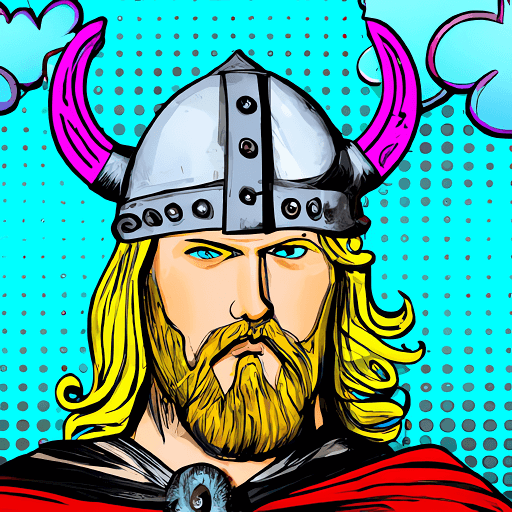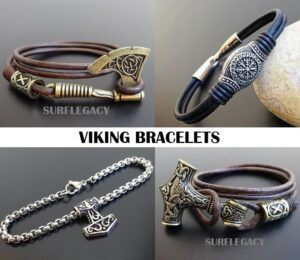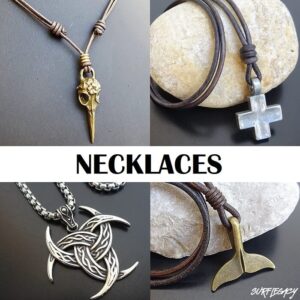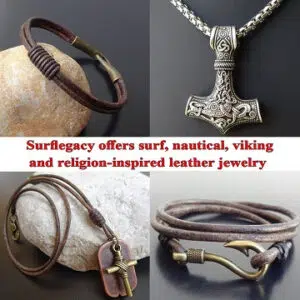Throughout the ages, stories and legends of the Vikings have spread across the globe. In recent decades, the popular image of Vikings has been romanticized and distorted.
Despite the often glamorous and fantastical retellings of the Viking Age, there remains much to be learned about this period in history. Myths, lies, and truths about the Vikings still abound, with some of the most commonly discussed stories being little more than fables.
In this blog post, we will delve into some of the myths, lies, and truths about the Vikings you didn’t know – a journey that will reveal some of the lesser-known stories behind this fascinating and powerful culture. Join us as we explore the fascinating world of the Viking Age!
1. Vikings were not all blond and tall
Contrary to popular belief, Vikings were not all blond and tall.
The Hollywood stereotype of Vikings as towering, blonde-haired warriors has been largely discredited by historical and archaeological evidence.
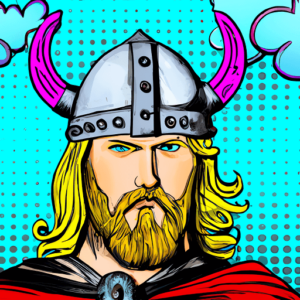
In reality, the Viking population was much more diverse, with a range of physical characteristics and cultural backgrounds.
Studies of remains from Viking burials have shown that people from different parts of the Viking world had different hair and eye color, as well as varying heights.
Some Vikings had dark hair and eyes, while others had lighter features.
Additionally, there is evidence that the Vikings had close connections to the cultures of the Mediterranean and the Middle East, and many had intermarried with people from these regions.
This mix of cultures and physical traits is reflected in the genetic makeup of modern Scandinavians, who are descendants of the Vikings.
It is also worth noting that the Vikings did not have a uniform appearance, as they did not wear standardized clothing or armor.
Instead, they dressed in a variety of styles that reflected their personal tastes and cultural traditions.
In short, the Vikings were a diverse and eclectic group of people, not the homogeneous, blond and tall warriors that are often portrayed in popular culture.
2. Vikings were not just raiders and warriors, but also merchants and farmers
It is a common misconception that vikings were nothing more than barbaric raiders and warriors. While it is true that this was part of their culture, vikings were also merchants and farmers.
In fact, many vikings made their living through trade and farming, using the spoils of their raids to supplement their main income.
Trade routes were established between viking countries and other parts of Europe, allowing them to engage in commerce and build large settlements.
Farming allowed the vikings to produce their own food and prevent famine in their communities.
The vikings were a highly organized and sophisticated society, and their skills in farming and trading are often overlooked in favor of their more famous raiding activities.
3. Norse mythology was not a religion followed by the Vikings, but rather a cultural belief system
One common myth about the Vikings is that Norse mythology was a religion that was actively followed by them.
However, this is not true. Norse mythology was a cultural belief system, not a religion. It was a set of stories, rituals, and ideals that the Vikings used to define their culture, explain the world around them, and help shape their daily behavior.
Even though the Vikings had a pantheon of gods and goddesses, they did not actively seek out worship or try to convert people to their beliefs.
Rather, the stories and rituals that made up Norse mythology were shared among them, and became part of their cultural identity.
4. Vikings did not wear horned helmets as popularly portrayed
One of the most pervasive myths about the Vikings is that they wore horned helmets into battle.
The truth is that there is no evidence that the Vikings ever actually wore helmets with horns or wings.
In fact, it’s likely that they didn’t even wear helmets at all. Instead, they relied on chainmail armor to protect their heads and faces.
So, while horned helmets have been an iconic symbol of the Vikings for centuries, they are nothing more than a myth.
5. The Viking longboat was not a battleship, but was primarily used for transportation
One of the most iconic images associated with the Vikings is that of their famous longboats, which were used to cross the seas and explore new lands.
However, contrary to popular belief, these vessels were not designed as battleships but were instead used mainly for transportation purposes.
In fact, they were surprisingly robust and efficient vessels that could carry large crews and their belongings over great distances.
This made them ideal for commerce and exploration, but they were far from a military threat, as they lacked the weaponry and defensive capabilities of a battleship.
Thus, the Vikings used them mainly for transportation, helping them to establish a considerable presence in Europe and beyond.
Contrary to popular belief, Vikings did not only inhabit the Scandinavian regions.
In the 9th century, many spread out to other regions of Europe and were known to be active traders and settlers.
In fact, they reached as far as the Mediterranean and the Middle East.
Vikings also settled in eastern and northern England, as well as Scotland, Ireland, France, and even Russia.
The famous Viking explorer, Leif Erikson, was even believed to have made his way to North America, long before Christopher Columbus.
This myth-busting fact is one of the most important truths about the Vikings that many people don’t know, and has been interesting to uncover. See also our article: Where Are Vikings From?
7. Viking raids were often motivated by a need for resources, not solely for conquering purposes
Myth: Viking raids were motivated solely by a desire to conquer.
Truth: Viking raids were often motivated by a need for resources, not just for conquering purposes.
This is because of their limited access to resources in their homelands. As a result, Vikings often raided for food, metal, and other resources.
In some cases, they also sought slaves and treasure. All of these factors contributed to their desire to raid and expand their territories.
While conquests were not their only goal, they were certainly a factor in their raids.
8. Vikings were advanced traders and traveled far distances for trade
For many centuries, the Vikings have been known as fierce warriors, but we often forget that they were also skilled traders.
The Vikings traveled far and wide to trade with other cultures, from the Caspian Sea to the Mediterranean.
They exchanged goods such as wool and other fabrics, honey, and hides for silk, spices, and coins from other countries.
They were also known to trade slaves for gold and silver, and the slave trade was an important part of their economy.
This intercontinental trade network was more advanced than many people realize.
9. Viking raids were often targeted toward monasteries, as they were wealthy
One of the most common misconceptions about the Vikings is the notion that their raids were simple plundering of wealth and resources.
While it is true that the Vikings were renowned for their raids, the truth is that many of these raids were targeted toward monasteries.
This is because monasteries were known to be quite wealthy, with generous donations and large amounts of gold, silver, and other precious objects.
Additionally, monasteries were considered to be relatively weak fortifications, making them particularly attractive targets for Viking raids.
In fact, some of the most successful raids in history were launched against monasteries.
These raids were not simply intended to amass wealth and resources, but to also spread fear and terrorize the population.
Viking ships were made from wood and were capable of being navigated on open seas, making them ideal for exploration and conquest.
The ships were engineered for strength, speed, and maneuverability, and were designed to be able to handle the rough seas of the North Atlantic.
The longship was the most common type of Viking vessel, and was known for its shallow draft, which allowed it to navigate in shallow waters and to beach for repairs.
The longship was also highly maneuverable, and its sleek design allowed it to travel at high speeds, making it ideal for raiding and pillaging along the coasts of Europe.
The Vikings also used a type of ship called a knarr, which was a larger, cargo-carrying vessel that was used for longer voyages and for transporting goods.
The knarr was more heavily built than the longship and had a deeper draft, which made it more suitable for ocean voyages.
The Vikings were known for their shipbuilding skills and their ability to construct vessels that were both sturdy and fast.
These ships played a crucial role in the expansion of the Viking maritime empire and enabled them to establish trade and commerce routes that spanned much of the North Atlantic.
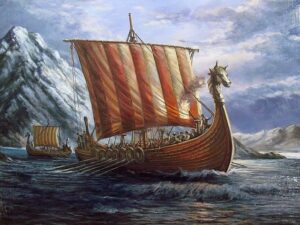
Viking drakkar
11. Viking society was highly stratified, with a strong emphasis on loyalty and honor
Despite popular beliefs, Viking society was highly stratified and organized, with a strong emphasis on loyalty and honor among its members.
At the top of the hierarchy were the chieftains, followed by the nobles and warriors. Below them were the freemen and then the slaves.
Within each of these categories, there were further distinctions based on wealth, status, and power. While the warriors were celebrated for their bravery and strength, their loyalty to the leader and the group was highly valued.
This loyalty was expected of all members of Viking society, regardless of their class. This emphasis on loyalty and honor was a major factor in the success of the Vikings and their reputation for being strong and reliable.
12. Viking women had more rights than other women in Europe
Viking women enjoyed more rights and freedoms compared to other women in Europe during the same time period.
In Viking society, women had the right to own property, inherit wealth, and engage in commerce. They could also initiate divorce and remarry, which was a rare privilege for women in Europe during the early Middle Ages.
Women also played important roles in the Viking community, serving as leaders, healers, and wise women.
The Vikings believed in the goddess Freya and the Valkyries, who were powerful female figures in their mythology, and this may have helped to shape the relatively equal status of women in Viking society.
Furthermore, women were also able to participate in warrior culture and could lead raids, as the legendary shieldmaiden Lagertha attests.
This level of equality and empowerment was unique for women during the early Middle Ages and sets the Vikings apart from many other societies in Europe at the time.
Despite their reputation as fierce warriors, their society had a complex social structure that shaped their daily lives.
At the top of this social structure was the Jarl, a Viking nobleman who wielded a great deal of power.
The Jarls were responsible for organizing raiding parties, settling disputes, and collecting taxes. They also owned large swaths of land and had the right to set up laws and hand out punishments.
Below the Jarls were the Karls, or commoners, who were responsible for farming, fishing, and trading.
Beneath the Karls were the Thralls, or slaves, who were often war captives or criminals. Thralls were forced to do manual labor and were not considered free people.
They were also denied basic rights and were not allowed to own property or marry. Despite the rigid social structure, the Vikings were a fairly egalitarian society. All free people had the right to own property, and all were considered equal under the law.
Additionally, the Vikings had a strong sense of honor, which was reflected in their laws and values.
Conclusion
Vikings were a complex group of people who have often been misunderstood or misrepresented in popular culture.
With advances in archaeological analysis, the truth about their lives and how they interacted with the world is becoming clearer.
We now know that they were skilled sailors and traders, highly organized, and a source of inspiration to many Europeans of their time.
Despite the myths and misunderstandings, the Vikings are fascinating people with a rich history that deserves to be explored and appreciated.

